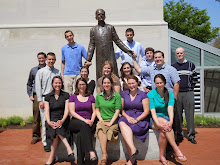Thursday, April 2, 2015
Remembering the Pope of the Family
“I would like to be remembered as the
pope of the family,” he said. And ten
years after his death, we remember St. John Paul II as a man who was passionate
about the family, about love and about the gift of human life.
St. John Paul II’s fifth anniversary of
death was Good Friday; his tenth is Holy Thursday. What might these coincidences tell us about
the first Polish pontiff? In many ways,
I think it underscores his life and his papacy as being “for” others.
 |
| Author's picture. |
One striking example is described in
George Weigel’s papal biography, Witness to Hope. In 1994, the United Nations was embattled in
preparations for the Cairo Conference on Population and Development. Worldwide promotion of abortion and birth
control was on the line. St. John Paul
II fought tirelessly to promote the good of human life, love and the
family. He called 1994 the Year of the
Family, and wrote a Letter to Families.
And then in the midst of the titanic
fight, John Paul II fell. He broke his
hip. His world stage became a hospital
bed, followed by a Sunday Angelus address, during which he shared the deeper
meaning he intuited behind his fall.
I understood that I have to lead
Christ’s Church into this third millennium by prayer, by various programs, but
I saw that this is not enough: she must be led by suffering, by the attack
thirteen years ago and by this new sacrifice. Why now, why this, why in this
Year of the Family? Precisely because the family is under attack. The Pope has
to be attacked, the Pope has to suffer, so that every family and the world may
see that there is ... a higher Gospel: the Gospel of suffering, by which the
future is prepared, the third millennium of families, of every family and of
all families. (As quoted in Witness to Hope
721)
St. John Paul II was willing to fight
for families to the point of being willing to suffer for them. It was a suffering that continued for 20 1/2
more years. A suffering that involved
hospital visits, a Parkinson’s diagnosis, the embarrassment of slurred speech
and failing limbs, the limitations of less travel and more rest.
Here was a man who lost his family at a
young age. He was the only living member
of the Wojtyla’s at age 20. Some would
have taken this suffering and resented families – seeing what others have, and
I have been denied. But for Karol
Wojtyla, his lack of a family only furthered his desire to defend the gift of
the family, to uphold the family’s dignity and to celebrate the role of the
family in the world. He “learned to love
human love” through his interactions with young couples as a newly ordained
priest in Poland. And he shared that
love until the day he died.
We could really say that this love of
human love is still being shared a decade after St. John Paul II’s death. His theological works, especially Theology of
the Body, are shared even more enthusiastically today than they were when he
first delivered them. His philosophical
works, especially Love and Responsibility, are
studied still. His encyclicals,
apostolic letters and exhortations, each with a reference to the family or to
the need for self-giving or to the love to which each human person is called,
are discussed today.
And his life! There are still images of a vigorous,
smiling, young pontiff, proclaiming to the world, “Do not be afraid!” His vigor inspires, and his articulate words
encourage. And then there are the images
of his final appearance at the Vatican window, unable to speak, a man clearly suffering. And a man who on his death bed, heard the
voices of the young, whom he spent his life and papacy inviting to embrace the
Gospel. He heard their songs and their
prayers and so beautifully said, “I have looked for you. Now you have come to
me. And I thank you.”
Ten years since our beloved Papa went to
the “house of the Father,” we are embarking upon the Triduum. It’s as if, even from heaven, St. John Paul
II is saying, “Don’t look at me. Look at
Him. All of my words, all of my
teachings, all of my suffering was meant to invite you to look to Love
Himself.”
May we too learn to love human
love. May our families be homes where
this love is cultivated. And may our
children and grandchildren know that the wizened pontiff with white wispy hair,
leaning on a crucifix for support is part of a family, our
family through his sacrifices, suffering and love.
Subscribe to:
Posts
(
Atom
)















